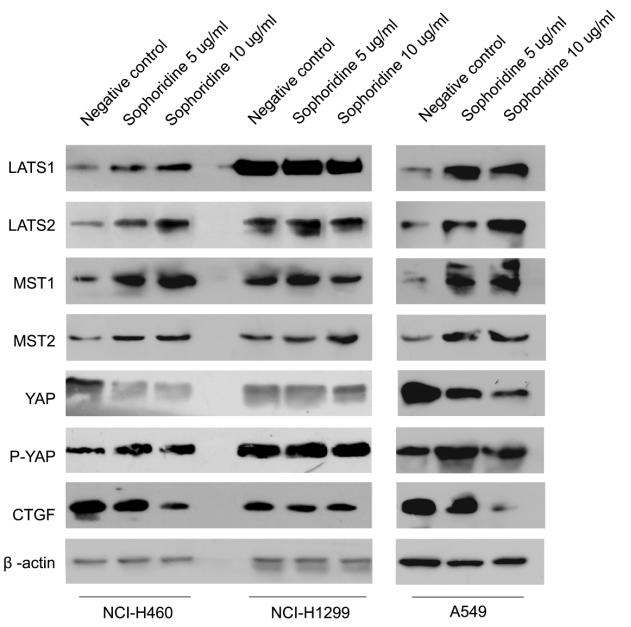LATS2 Antibody - #AF7940
| 製品: | LATS2 Antibody |
| カタログ: | AF7940 |
| タンパク質の説明: | Rabbit polyclonal antibody to LATS2 |
| アプリケーション: | WB |
| Cited expt.: | WB |
| 反応性: | Human, Mouse |
| 予測: | Pig, Zebrafish, Bovine, Horse, Sheep, Rabbit, Dog, Xenopus |
| 分子量: | 150kDa; 120kD(Calculated). |
| ユニプロット: | Q9NRM7 |
| RRID: | AB_2844303 |
製品説明
*The optimal dilutions should be determined by the end user. For optimal experimental results, antibody reuse is not recommended.
*Tips:
WB: For western blot detection of denatured protein samples. IHC: For immunohistochemical detection of paraffin sections (IHC-p) or frozen sections (IHC-f) of tissue samples. IF/ICC: For immunofluorescence detection of cell samples. ELISA(peptide): For ELISA detection of antigenic peptide.
引用形式: Affinity Biosciences Cat# AF7940, RRID:AB_2844303.
折りたたみ/展開
FLJ13161; Kinase phosphorylated during mitosis protein; KPM; Large tumor suppressor homolog 2; Large tumor suppressor homolog 2 Drosophila; Large tumor suppressor kinase 2; LATS large tumor suppressor Drosophila homolog 2; LATS large tumor suppressor homolog 2; Lats2; LATS2_HUMAN; Serine/threonine kinase kpm; Serine/threonine protein kinase kpm; Serine/threonine-protein kinase kpm; Serine/threonine-protein kinase LATS2; Warts like kinase; Warts-like kinase;
免疫原
A synthesized peptide derived from human LATS2, corresponding to a region within the internal amino acids.
Expressed at high levels in heart and skeletal muscle and at lower levels in all other tissues examined.
- Q9NRM7 LATS2_HUMAN:
- Protein BLAST With
- NCBI/
- ExPASy/
- Uniprot
MRPKTFPATTYSGNSRQRLQEIREGLKQPSKSSVQGLPAGPNSDTSLDAKVLGSKDATRQQQQMRATPKFGPYQKALREIRYSLLPFANESGTSAAAEVNRQMLQELVNAGCDQEMAGRALKQTGSRSIEAALEYISKMGYLDPRNEQIVRVIKQTSPGKGLMPTPVTRRPSFEGTGDSFASYHQLSGTPYEGPSFGADGPTALEEMPRPYVDYLFPGVGPHGPGHQHQHPPKGYGASVEAAGAHFPLQGAHYGRPHLLVPGEPLGYGVQRSPSFQSKTPPETGGYASLPTKGQGGPPGAGLAFPPPAAGLYVPHPHHKQAGPAAHQLHVLGSRSQVFASDSPPQSLLTPSRNSLNVDLYELGSTSVQQWPAATLARRDSLQKPGLEAPPRAHVAFRPDCPVPSRTNSFNSHQPRPGPPGKAEPSLPAPNTVTAVTAAHILHPVKSVRVLRPEPQTAVGPSHPAWVPAPAPAPAPAPAPAAEGLDAKEEHALALGGAGAFPLDVEYGGPDRRCPPPPYPKHLLLRSKSEQYDLDSLCAGMEQSLRAGPNEPEGGDKSRKSAKGDKGGKDKKQIQTSPVPVRKNSRDEEKRESRIKSYSPYAFKFFMEQHVENVIKTYQQKVNRRLQLEQEMAKAGLCEAEQEQMRKILYQKESNYNRLKRAKMDKSMFVKIKTLGIGAFGEVCLACKVDTHALYAMKTLRKKDVLNRNQVAHVKAERDILAEADNEWVVKLYYSFQDKDSLYFVMDYIPGGDMMSLLIRMEVFPEHLARFYIAELTLAIESVHKMGFIHRDIKPDNILIDLDGHIKLTDFGLCTGFRWTHNSKYYQKGSHVRQDSMEPSDLWDDVSNCRCGDRLKTLEQRARKQHQRCLAHSLVGTPNYIAPEVLLRKGYTQLCDWWSVGVILFEMLVGQPPFLAPTPTETQLKVINWENTLHIPAQVKLSPEARDLITKLCCSADHRLGRNGADDLKAHPFFSAIDFSSDIRKQPAPYVPTISHPMDTSNFDPVDEESPWNDASEGSTKAWDTLTSPNNKHPEHAFYEFTFRRFFDDNGYPFRCPKPSGAEASQAESSDLESSDLVDQTEGCQPVYV
種類予測
Score>80(red) has high confidence and is suggested to be used for WB detection. *The prediction model is mainly based on the alignment of immunogen sequences, the results are for reference only, not as the basis of quality assurance.
High(score>80) Medium(80>score>50) Low(score<50) No confidence
研究背景
Negative regulator of YAP1 in the Hippo signaling pathway that plays a pivotal role in organ size control and tumor suppression by restricting proliferation and promoting apoptosis. The core of this pathway is composed of a kinase cascade wherein STK3/MST2 and STK4/MST1, in complex with its regulatory protein SAV1, phosphorylates and activates LATS1/2 in complex with its regulatory protein MOB1, which in turn phosphorylates and inactivates YAP1 oncoprotein and WWTR1/TAZ. Phosphorylation of YAP1 by LATS2 inhibits its translocation into the nucleus to regulate cellular genes important for cell proliferation, cell death, and cell migration. Acts as a tumor suppressor which plays a critical role in centrosome duplication, maintenance of mitotic fidelity and genomic stability. Negatively regulates G1/S transition by down-regulating cyclin E/CDK2 kinase activity. Negative regulator of the androgen receptor. Phosphorylates SNAI1 in the nucleus leading to its nuclear retention and stabilization, which enhances its epithelial-mesenchymal transition and tumor cell invasion/migration activities. This tumor-promoting activity is independent of its effects upon YAP1 or WWTR1/TAZ.
Autophosphorylated and phosphorylated during M-phase and the G1/S-phase of the cell cycle. Phosphorylated and activated by STK3/MST2.
Cytoplasm>Cytoskeleton>Microtubule organizing center>Centrosome. Cytoplasm. Cytoplasm>Cytoskeleton>Spindle pole. Nucleus.
Note: Colocalizes with AURKA at the centrosomes during interphase, early prophase and cytokinesis. Migrates to the spindle poles during mitosis, and to the midbody during cytokinesis. Translocates to the nucleus upon mitotic stress by nocodazole treatment.
Expressed at high levels in heart and skeletal muscle and at lower levels in all other tissues examined.
Belongs to the protein kinase superfamily. AGC Ser/Thr protein kinase family.
研究領域
· Environmental Information Processing > Signal transduction > Hippo signaling pathway. (View pathway)
· Environmental Information Processing > Signal transduction > Hippo signaling pathway - multiple species. (View pathway)
参考文献
Application: WB Species: human Sample: NCI-H460、A549 cells and p53-deficient NCI-H1299 cells
Restrictive clause
Affinity Biosciences tests all products strictly. Citations are provided as a resource for additional applications that have not been validated by Affinity Biosciences. Please choose the appropriate format for each application and consult Materials and Methods sections for additional details about the use of any product in these publications.
For Research Use Only.
Not for use in diagnostic or therapeutic procedures. Not for resale. Not for distribution without written consent. Affinity Biosciences will not be held responsible for patent infringement or other violations that may occur with the use of our products. Affinity Biosciences, Affinity Biosciences Logo and all other trademarks are the property of Affinity Biosciences LTD.

